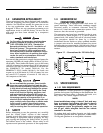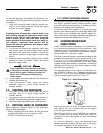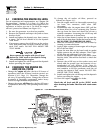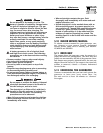
10 Generac
®
Power Systems, Inc.
Section 2 – Operation
PRIMEPACT 50 Recreational Vehicle Generator
2.8.1 DO NOT OVERLOAD THE GENERATOR
You can read the rated wattage/amperage capacity of
your generator on the generator data decal (see
Section 1.1 on Page 4).
Applying electrical loads in excess of the unit’s rated
capacity will cause the engine/generator to automati-
cally shut down.
To avoid overloading, add up the wattage of all con-
nected electrical lighting, appliance, tool and motor
loads. This total should not be greater than the gen-
erator’s rated wattage capacity.
• Most lighting, appliance, tool and motor loads indi-
cate their required watts on their nameplate or
data plate. For light bulbs, simply note the wattage
rating of the bulb.
• If a load does not show its rated wattage, multiply
that load’s rated VOLTS times AMPS to obtain
WATTS.
• Induction type motors (such as those that run the
vehicle’s furnace fan, refrigerator, air conditioner,
etc.) need about 2-1/2 time more watts of power for
starting than for running (for a few seconds during
motor starting). Be sure to allow for this when con-
necting electrical loads to the generator. First, fig-
ure the watts needed to start electric motors in the
system. To that figure, add the running wattages of
other items that will be operated by the generator.
• Do not apply heavy electrical loads for the first two
or three hours of operation.
2.9 PROTECTION SYSTEMS
2.9.1 LOW OIL PRESSURE SWITCH
This switch (Figure 2.3) has normally closed (N.C.)
contacts that are held open by engine oil pressure dur-
ing cranking and operating. Should oil pressure drop
below a preset level, switch contacts close, and the
engine automatically shuts down. The unit should not
be restarted until oil is added.
2.9.2 HIGH TEMPERATURE SWITCH
This switch (Figure 2.3), which has normally open
(N.O.) contacts, is mounted near the oil filter. The
contacts close if the temperature should exceed
approximately 293º F (145º C), initiating an engine
shutdown.
Figure 2.3 – Low Oil Pressure and
High Temperature Switches
2.9.3 FIELD BOOST
The Controller Circuit Board houses a field boost
diode and resistor that are not part of the automatic
choke circuit. These two components are part of a
“field boost” circuit (Figure 2.4). During engine
cranking only, a positive DC (battery) voltage is deliv-
ered through the diode, resistor, brushes and slip
rings, and the generator rotor. Application of this
voltage to the rotor “flashes the field” whenever it is
started. Flashing of the field each time the generator
starts makes sure that a sufficiently strong magnetic
field is available to produce “pickup” voltage in the
stator windings.
Figure 2.4 – Field Boost Circuit
◆
◆
◆
◆


















